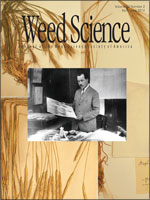Weed management remains a high priority for organic farmers, whose fields generally have higher weed density and species diversity than those of their conventional counterparts. We explored whether variability in farmer knowledge and perceptions of weeds and weed management practices were predictive of variability in on-farm weed seedbanks on 23 organic farms in northern New England. We interviewed farmers and transcribed and coded interviews to quantify their emphasis on concepts regarding knowledge of ecological weed management, the perceived risks and benefits of weeds, and the perceived risks and benefits of weed management practices. To characterize on-farm weed seedbanks, we collected soil samples from five fields at each farm (115 fields total) and measured germinable weed seed density. Mean weed seed density per farm ranged from 2,775 seeds m−2 to 24,678 seeds m−2 to a soil depth of 10 cm. Farmers most often reported hairy galinsoga and crabgrass species (Digitaria spp.) as their most problematic weeds. The proportion of the sum of these two most problematic weeds in each farm's seedbank ranged from 1 to 73% of total weed seed density. Farmer knowledge and perceptions were predictive of total seed density, species richness, and proportion of hairy galinsoga and crabgrass species. Low seed densities were associated with farmers who most often discussed risks of weeds, benefits of critical weed-free management practices, and learning from their own experience. These farmers also exhibited greater knowledge of managing the weed seedbank and greater understanding of the importance of a long-term strategy. Targeted education focusing on this set of knowledge and beliefs could potentially lead to improved application and success of ecological weed management in the future, thus decreasing labor costs and time necessary for farmers to manage weeds.
Nomenclature: Large crabgrass, Digitaria sanguinalis (L.) Scop. DIGSA; smooth crabgrass, Digitaria ischaemum (Schreb.) Schreb. ex Muhl. DIGIS; hairy galinsoga, Galinsoga quadriradiata Cav. GAQU.






